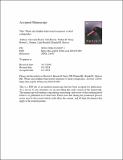Files in this item
Whale and dolphin behavioural responses to dead conspecifics
Item metadata
| dc.contributor.author | Bearzi, Giovanni | |
| dc.contributor.author | Kerem, Dan | |
| dc.contributor.author | Furey, Nathan B. | |
| dc.contributor.author | Pitman, Robert L. | |
| dc.contributor.author | Rendell, Luke Edward | |
| dc.contributor.author | Reeves, Randall R. | |
| dc.date.accessioned | 2019-05-08T23:37:16Z | |
| dc.date.available | 2019-05-08T23:37:16Z | |
| dc.date.issued | 2018-06 | |
| dc.identifier | 253076467 | |
| dc.identifier | 32e7c45e-4773-4446-8766-9a47a864fb41 | |
| dc.identifier | 85048202978 | |
| dc.identifier | 000440394000001 | |
| dc.identifier.citation | Bearzi , G , Kerem , D , Furey , N B , Pitman , R L , Rendell , L E & Reeves , R R 2018 , ' Whale and dolphin behavioural responses to dead conspecifics ' , Zoology , vol. 128 , pp. 1-15 . https://doi.org/10.1016/j.zool.2018.05.003 | en |
| dc.identifier.issn | 0944-2006 | |
| dc.identifier.other | ORCID: /0000-0002-1121-9142/work/60428001 | |
| dc.identifier.uri | https://hdl.handle.net/10023/17672 | |
| dc.description.abstract | The scientific study of death across animal taxa—comparative thanatology—investigates how animals respond behaviourally, physiologically and psychologically to dead conspecifics, and the processes behind such responses. Several species of cetaceans have been long known to care for, attend to, be aroused by, or show interest in dead or dying individuals. We investigated patterns and variation in cetacean responses to dead conspecifics across cetacean taxa based on a comprehensive literature review. We analysed 78 records reported between 1970 and 2016, involving 20 of the 88 extant cetacean species. We adopted a weighted comparative approach to take observation effort into account and found that odontocetes (toothed cetaceans) were much more likely than mysticetes (baleen whales) to attend to dead conspecifics. Dolphins (Delphinidae) had the greatest occurrence of attentive behaviour (92.3% of all records, with a weighed attendance index 18 times greater than the average of all other cetacean families). Two dolphin genera, Sousa and Tursiops, constituted 55.1% of all cetacean records (N = 43) and showed the highest incidence of attentive behaviour. Results of analyses intended to investigate the reasons behind these differences suggested that encephalisation may be an important predictor, consistent with the "social brain" hypothesis. Among attending individuals or groups of known sex (N = 28), the majority (75.0%) were adult females with dead calves or juveniles (possibly their own offspring, with exceptions), consistent with the strong mother-calf bond, or, in a few cases, with the bond between mothers and other females in the group. The remaining records (25.0%) involved males either showing sexual interest in a dead adult or subadult, or carrying a dead calf in the presence of females. Because an inanimate individual is potentially rescuable, responses to dead conspecifics—especially by females—can be explained at least in part by attempts to revive and protect, having a clear adaptive value. In some cases such responses are followed by apparently maladaptive behaviour such as the long-term carrying of, or standing by, a decomposed carcass, similar to observations of other terrestrial mammals. Among the possible explanations for the observed cetacean behavioural responses to dead conspecifics are strong attachment resulting in a difficulty of "letting go"—possibly related to grieving—or perhaps individuals failing to recognise or accept that an offspring or companion has died. Our current understanding is challenged by small sample size, incomplete descriptions, and lack of information on the physiology and neural processes underpinning the observed behaviour. We provide research recommendations that would improve such understanding. | |
| dc.format.extent | 15 | |
| dc.format.extent | 1232179 | |
| dc.language.iso | eng | |
| dc.relation.ispartof | Zoology | en |
| dc.subject | Cetaceans | en |
| dc.subject | Epimeletic behaviour | en |
| dc.subject | Caregiving behaviour | en |
| dc.subject | Comparative thanatology | en |
| dc.subject | Grieving | en |
| dc.subject | QL Zoology | en |
| dc.subject | 3rd-DAS | en |
| dc.subject.lcc | QL | en |
| dc.title | Whale and dolphin behavioural responses to dead conspecifics | en |
| dc.type | Journal article | en |
| dc.contributor.institution | University of St Andrews. School of Biology | en |
| dc.contributor.institution | University of St Andrews. Centre for Social Learning & Cognitive Evolution | en |
| dc.contributor.institution | University of St Andrews. Sea Mammal Research Unit | en |
| dc.contributor.institution | University of St Andrews. Marine Alliance for Science & Technology Scotland | en |
| dc.contributor.institution | University of St Andrews. Bioacoustics group | en |
| dc.contributor.institution | University of St Andrews. Centre for Biological Diversity | en |
| dc.identifier.doi | 10.1016/j.zool.2018.05.003 | |
| dc.description.status | Peer reviewed | en |
| dc.date.embargoedUntil | 2019-05-09 | |
| dc.identifier.url | https://www.sciencedirect.com/science/article/pii/S0944200618300473 | en |
This item appears in the following Collection(s)
Items in the St Andrews Research Repository are protected by copyright, with all rights reserved, unless otherwise indicated.

